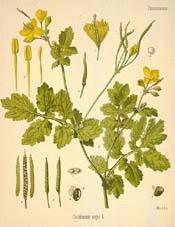
Botanical.com Home Page

|
Celandine, Greater
(Chelidonium majus)
Click on graphic for larger image
|
Celandine, Greater
Botanical: Chelidonium majus (LINN.)
Family: N.O. Papaveraceae
---Synonyms---Common Celandine. Garden Celandine.
---Part Used---Herb.
---Habitat---Found by old walls, on waste ground and in hedges, nearly always in the neighbourhood of human habitations.
---Description---At first glance, the four petals arranged in the form of a cross make it appear a member of the order Cruciferce, but it is not related to these plants, belonging to the same family as the Poppies (Papaveraceae) and has, like these flowers, a dense mass of stamens in the centre of its blossoms.
The Celandine is a herbaceous perennial. The root is thick and fleshy. The stem, which is slender, round and slightly hairy, grows from 1 1/2 to 3 feet high and is much branched; at the points where the branches are given off, it is swollen and jointed and breaks very easily.
The whole plant abounds in a bright, orange-coloured juice, which is emitted freely wherever the stems or leaves are broken. This juice stains the hands strongly and has a persistent and nauseous taste and a strong, disagreeable smell. It is acrid and a powerful irritant.
The yellowish-green leaves, which are much paler, almost greyish below, are very thin in texture, drooping immediately on gathering. They are graceful in form and slightly hairy, 6 to 12 inches long, 2 to 3 inches wide, deeply divided as far as the central rib, so as to form usually two pairs of leaflets, placed opposite to one another, with a large terminal leaflet. The margins (i.e. edges) of the leaflets are cut into by rounded teeth.
The flowers drop very quickly when picked. They are arranged at the ends of the stems in loose umbels. They blossom throughout the summer, being succeeded by narrow, long pods, containing blackish seeds.
[Top]
---History---This plant is undoubtedly the true Celandine, having nothing in common with the Lesser Celandine except the colour of its flowers. It was a drug plant in the Middle Ages and is mentioned by Pliny, to whom we owe the tradition that it is called Chelidonium from the Greek chelidon (a swallow), because it comes into flower when the swallows arrive and fades at their departure. (The English name Celandine is merely a corruption of the Greek word.) Its acrid juice has been employed successfully in removing films from the cornea of the eye, a property which Pliny tells us was discovered by swallows, this being a double reason why the plant should be named after these birds.
- Gerard says:
- 'the juice of the herbe is good to sharpen the sight, for it cleanseth and consumeth away slimie things that cleave about the ball of the eye and hinder the sight and especially being boiled with honey in a brasen vessell, as Dioscorides teacheth.'
It is one of the twenty-four herbs mentioned in Mercer's Herbal.
In the fourteenth century, a drink made with Celandine was supposed to be good for the blood. Clusius, the celebrated Dutch botanist, considered that the juice, dropped into small green wounds, effected rapid cure, and when dropped into the eye would take away specks and stop incipient suffusions. The old alchemists held that it was good to 'superstifle the jaundice,' because of its intense yellow colour.
[Top]
---Part Used---The whole herb, collected in the wild state, from May to July, when in flower, and dried. Likewise, the fresh juice.
---Constituents---The alkaloids Chelidonine and Chelerythrin, the latter narcotic and poisonous, also the two nearly allied alkaloids, Homochelidonine A, and Homocheli donine B. In addition, Protopine and Sanguinarine, and a body named Chelidoxanthin, a neutral bitter principle.
---Medicinal Action and Uses---Alterative, diuretic, purgative. It is used in jaundice, eczema, scrofulous diseases, etc., the infusion of 1 OZ. of the dried herb to a pint of boiling water being taken in wineglassful doses. The infusion is a cordial and greatly promotes perspiration. The addition of a few aniseeds in making a decoction of the herb in wine has been held to increase its efficacy in removing obstructions of the liver and gall.
A fluid extract is also prepared, the dose being 1/2 to 1 drachm. Eight to 10 drops of the tincture made from the whole herb, or of the fresh juice, given as a dose three times a day in sweetened water, is considered excellent for overcoming torpid conditions of the liver. In the treatment of the worst forms of scurvy it has been given with benefit.
The orange-coloured, acrid juice is commonly used fresh to cure warts, ringworm and corns, but should not be allowed to come into contact with any other part of the skin.
In milk, it is employed as an eye-lotion, to remove the white, opaque spots on the cornea. Mixed with sulphur, it was formerly used to cure the itch.
An ointment made of the roots and lard boiled together, also of the leaves and flowers, has been used with advantage for piles.
Celandine is a very popular medicine in Russia, where it is said to have proved effective in cases of cancer.
It is still used in Suffolk as a fomentation for toothache.
[Top]
Common Name Index
A MODERN HERBAL Home Page
Bear in mind "A Modern Herbal" was written with the conventional wisdom of the early 1900's. This should be taken into account as some of the information may now be considered inaccurate, or not in accordance with modern medicine.
© Copyright Protected 1995-2025 Botanical.com
|

